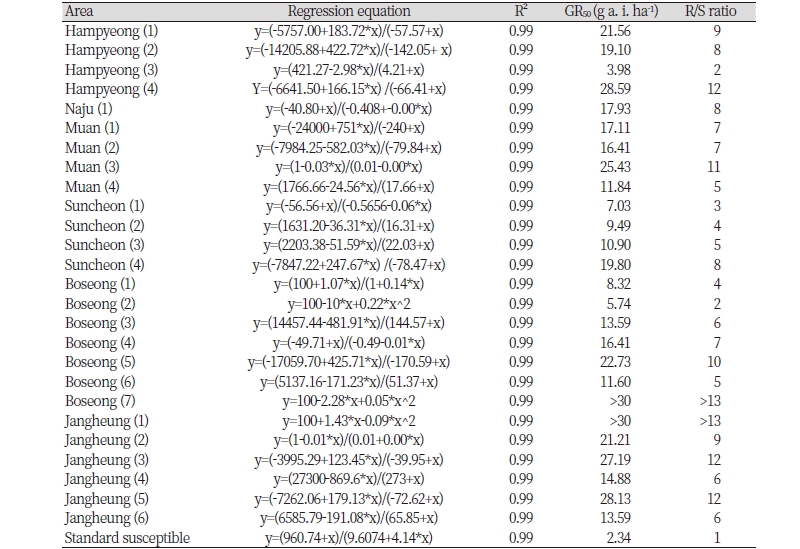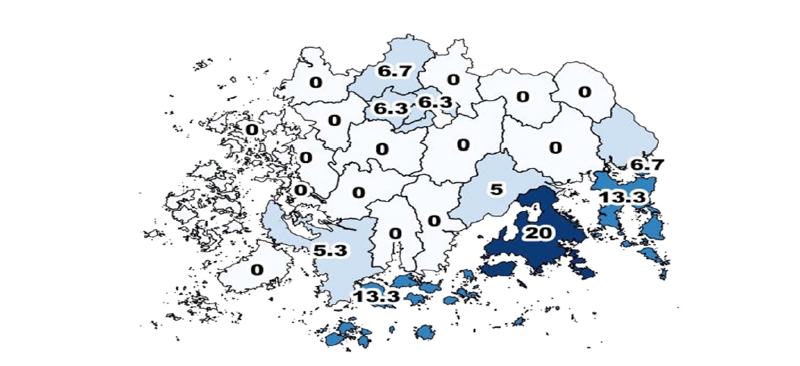서론
2018년 현재까지 총 69개국의 91개 작물재배지에서 255종 중 단자엽식물 107종과 쌍자엽식물 148종이 제초제에 저항성으로 보고되었다(Heap, 2018). 우리나라에서는 1998년 서해안 간척지 논에서 acetolactate synthase (ALS) 저해 제초제 저항성 물옥잠(Monochoria korsakowii)이 처음으로 보고된 이후(Park et al., 1999), 저항성 물달개비(Monochoria vaginalis), 미국외풀(Lindernia dubia), 마디꽃(Rotala indica) 등의 일년생 잡초들이 보고되었다(Kwon et al., 2000; Kuk et al., 2002; Park and Park, 2002; Kuk et al., 2004). 또한 올챙이고랭이(Scirpus juncoides), 올미(Sagittaria pigmaea), 쇠털골(Eleocharis acicularis) 및 새섬매자기(Scirpus planiculmis) 등의 다년생잡초들에서도 ALS 저해 제초제에 대한 저항성이 확인되었다(Im et al., 2005; Kwon et al., 2009; Park et al., 2006). 일년생과 다년생을 합하여 국내에서는 2018년 현재까지 ALS 저해제 제초제에 저항성 논잡초 14종이 보고되었다(Kim et al., 2018). 또한 우리나라와 제초제 사용 양상이 비슷한 일본의 경우는 ALS 저해제 저항성 논잡초가 21종이 보고되었다(Heap, 2018).
우리나라 경우 이들 저항성 잡초종의 군락 및 개체수는 빠른 속도로 확대되고 있다. 실제로 2012년에 ALS 저해 제초제 저항성 논잡초의 발생면적은 전국 논면적의 22.1%에 달하는 약 176,870 ha로 조사되었다(Lee et al., 2012; Lee et al., 2013; Park et al., 2011). 그러나 2017년 조사에서 ALS 저해제 저항성 잡초 의 발생비율은 전남의 경우 저항성 발생비율이 51.5% (Jeong et al., 2018), 전북 68.9% (Choi et al., 2018), 경기도 77.3%, 강원도 75.3% (Lim et al., 2018), 충남 47% (Won et al., 2018), 충북 80.6% (Lee et al., 2018) 등 대부분의 지역에서 2012년에 비해 2배 이상 증가한 것으로 보고되었다. 농경지내에 저항성 잡초가 발생하면 작물과의 경합으로 인하여 작물의 수량이 심하게 감소한다. 예를 들면 ALS 저해 제 제초제 저항성 물달개비가 심하게 발생한 벼 직파와 이앙재배에서 벼 수량이 각각 70%와 31% 감소하였다(Kuk et al.,2003).
여뀌바늘(Ludwigia prostrata Roxb.)은 논, 밭, 논둑 및 습지에서 종자로 번식하는 바늘꽃과 일년생 잡초로 수심이 얕은 곳에서 주로 발생한다(National Institute of Agricultural Sciences, 2001). 원줄기는 곧추 또는 비스듬히 서며 가지가 많이 갈라지고 논에서 방제가 되지 않으면 벼보다 키가 크게 자란다. 따라서 이러한 형태적 특성 때문에 벼보다 경합에 우위성을 확보한다. 실제로 여뀌바늘은 벼 담수직파재배에서 m2당 24본 이상이 발생할 경우 벼 수량이 유의적으로 감소하고 m2당 192본이 발생한 경우 38% 수량이 감소하였다(Kwon et al., 2010). 최근 우리나라 논에 발생하는 잡초를 보면 지역별로 약간 차이는 있지만 피속(Echinochlora)류, 물달개비, 올챙이고랭이, 올방개(Eleocharis kuroguwai), 여뀌바늘, 벗풀 (Sagittaria trifolia), 밭뚝외풀(Lindernia procumbens), 자귀풀(Aeschynomene indica), 가막사리(Bidens tripartita), 미국가막사리(Bidens frondosa)가 10대 우점잡초이다(Lee et al., 2017). 이들 우점잡초 중 여뀌바늘은 최근 발생량이 증가하여 방제 방법 등에 대해 농가로부터 민원이 많은 실정이다. 이러한 여뀌바늘 발생이 증가한 이유 중의 하나로서 ALS 저해 제초제에 대한 저항성 개체의 증가로 예상할 수 있다. 실제로 여뀌바늘은 ALS 저해제 제초제 저항성으로 보고되었으나(Park et al., 2013), 표준감수성을 사용한 약량반응 연구가 수행되지 않았을 뿐만 아니라 저항성 여뀌바늘에 대한 연구가 극히 제한적이다.
따라서 본 연구는 토양검정법에 의해 ALS 저해제 제초제(Imazosulfuron+pyriminobac-methyl)에 대한 광주, 전남지역 수집의 여뀌바늘 저항성 분포와 ALS 저해 제초제인 penoxsulam에 대한 여뀌바늘 저항성 수준을 종자와 유묘검정법을 이용하여 검정하기 위해 수행하였다.
재료 및 방법
토양검정법에 의한 제초제 저항성 여뀌바늘 분포
ALS 저해제 제초제 저항성 여뀌바늘 발생 양상을 조사하기 위하여 광주광역시를 포함한 전라남도 23개 시·군에서 2017년 3월부터 4월까지 총 358지점 토양을 채취하였다. 구체적인 논토양 채취 지점과 채취 방법은 Jeong et al. (2018) 연 구와 동일하게 하였다. 각 조사지점에서 채취한 토양을 2017년 5월 11일에 사각 포트(12 cm×18 cm×10 cm)에 충진하고 담수하여 써레질 조건이 되도록 토양을 손으로 혼합하여 주었다. 이때 사각 포트의 담수 깊이는 2 cm 내외로 유지하 였다. 사각포트에 여뀌바늘이 발생하였을 때(담수 후 20일) sulfonylurea계 Imazosulfuron (1.5%)과 pyrimidinyl oxybenzoic 계 pyriminobac-methyl (0.6%) 혼합제를 표준량인 75+30 g a.i. ha-1로 수면처리하였다. 처리 후 30일에 처리구와 무처리구에서 생존한 여뀌바늘 개체수를 조사하였다. 저항성 발생 지점은 처리구에서 여뀌바늘이 한 개체 이상 생존한 것으로, 감수성 지점은 생존한 개체가 없을 때로 하였다. 시·군의 ALS 저해제 저항성 여뀌바늘 발생률은 아래 수식(1)을 이용하 여 산출하였다. 산출 후 QGIS (2012, http://www.qgis.org) 지리정보소프트웨어를 이용하여 저항성 여뀌바늘 발생분포도를 작성하였다. 또한 시·군의 저항성 여뀌바늘 발생 논 면적은 각 시·군의 논 면적(Statistics Korea, 2017)을 근거로 하여 아래 수식(2)을 이용하여 산출하였다.
시·군의 저항성 여뀌바늘 발생률(%) =저항성 여뀌바늘 발생/시·군의 전체 지점수×100 (1)
시·군의 저항성 여뀌바늘 예상 발생 면적(ha) =저항성 여뀌바늘 발생면적/ 시·군의 전체 지점수×100 (2)
Seed bioassay법에 의한 여뀌바늘 수집종의 penoxsulam에 대한 저항성 수준
본 실험에 사용된 여뀌바늘 종자는 2016년 10월에 전남 6개 시·군 27개 지역(Table 1, Table 2)에서 채집하여 종자를 정선하여 실험에 사용할 때까지 4℃ 저온냉장고에서 보관하였다. 여뀌바늘 종자 약 100개를 2 mL 튜브에 넣고, penoxsulam (3% SC, 살초대첩)을 0, 0.1, 1, 10, 100 및 1000 μM로 조제하여 0.5 mL씩 처리하였다. 처리 후 생장실은 주야간 온도 28/20±2℃, 상대습도 60% 그리고 주야간 광주기 12/10시간 및 광량(100 μmolm-2 s-1) 조건으로 하였다. 처리 후 15일째에 지상부 생체중을 조사하여 GR50 값을 계산한 후 각각의 표준 감수성 여뀌바늘의 GR50 값과 비교하여 저항성/감수성(R/S) 비율을 계산하였다. R/S값이 2 이상일 때 저항성으로 평가하였다. 표준감수성 종자는 최근 5년간 제초제를 사용하지 않은 벼 유기재배 포장에서 수집되었다.
Whole plant bioassay법에 의한 여뀌바늘 수집종의 penoxsulam에 대한 저항성 수준
위 실험 seed bioassay에서 사용한 여뀌바늘 종자를 와그너포트(1/5000 a)에 파종하고, 온실에서 생육시켰다. 온실조건은 주야간 온도 30/20±2℃, 상대습도 50% 그리고 주야간 광주기 12/10시간 및 광량(500 μmolm-2 s-1) 이었다. 파종 후 21일(2엽기)에 penoxsulam (3% SC, 살초대첩)을 표준량(30 g a.i. ha-1)의 1/16, 1/8, 1/4, 1/2 및 표준량으로 경엽에 처리한 후 20일에 생체중을 조사하였다. 각 처리 농도의 여뀌바늘에 대한 지상부 생체중 자료를 이용하여 GR50 값을 계산한 후 위와 동일한 방법으로 저항성을 평가하였다.
결과 및 고찰
토양검정법에 의한 제초제 저항성 여뀌바늘 분포
Seed bioassay법에 의한 여뀌바늘 수집종의 penoxsulam에 대한 저항성 수준
위의 토양검정법 연구결과에 의하면 전남지역 여뀌바늘 수집종 중 ALS 저해 제초제에 3.3%가 저항성으로 확인되었다. 따라서 벼 수확기 논 포장의 26개 지역으로부터 여뀌바늘 종자를 수집하여 ALS 저해제 중 하나인 penoxsulam에 저 항성 검정을 seed bioassay법으로 알아보았다(Table 1). 수집한 여뀌바늘 중 장흥(4) 수집종의 GR50 값은 15.63 μM로 표준감수성 GR50 값인 3.91 μM과 비교시 4배 더 높은 저항성을 보였다. 장흥(4)의 약량 반응 곡선은 Fig. 3A와 같다. 또한 무 안(2)와 보성(3) 수집종이 표준감수성에 비해 3배 더 높은 저항성을 보였고 그 밖의 여뀌바늘 9개 지역에서 표준감수성 에 비해 2배 더 높은 저항성을 보였다. 종합적으로 볼 때 여뀌바늘은 26개 지역 중 12지역에서 저항성을 보였으며 저항성 발생률은 46.1%로 나타났다. 이와 같이 토양검정법에 의한 저항성 발생비율보다는 seed bioassay법에 의해 저항성 발생률이 증가하였으나 이들 두 방법을 직접적으로 비교하기는 어려울 것으로 사료된다. 즉 토양검정에 사용된 제초제의 경우는 ALS 혼합제인 imazosulfuron과 pyriminobac-methyl를 그리고 seed bioassay 경우는 ALS 저해제인 penoxsulam를 사용하였다. 또한 seed bioassay법에 의한 저항성 정도는 일부 수집 지역을 제외하고는 표준 감수성에 비해 크지 않았다.
Whole plant bioassay법에 의한 여뀌바늘 수집종의 penoxsulam에 대한 저항성 수준
위의 두 저항성 검정법의 문제점을 보완하기 위하여 일반적으로 저항성 검정에 사용되는 whole plant bioassay법을 사용하여 26개 지역에서 수집한 여뀌바늘에 대해 penoxsulam에 저항성 수준을 검정하였다(Table 2). 여뀌바늘 수집 지역 중 보성(7)과 장흥(1)의 여뀌바늘의 경우 GR50 값이 penoxsulam 표준사용량 30 g ai ha-1 이상으로 표준감수성에 비해 약 13배 이상의 가장 높은 저항성을 나타냈다. 이들 약량 반응 곡선은 Fig. 3B와 같다. 또한 함평(4), 무안(3), 보성(5), 장흥(3) 및 장흥(5)의 5개지역은 표준감수성에 비해 10-12배 이상 저항성으로 나타났다. 그 밖의 19개 지역에서도 표준감수성에 비해 2배 이상 저항성으로 나타났다. 즉 whole plant bioassay법에 의해 비록 26개 지역 수집 종간에 저항성 수준은 다 르지만 100% 저항성인 것을 의미한다. 따라서 본 연구결과는 논 포장에서 벼 수확기에 수집한 여뀌바늘 종자 대부분은 penoxulam에 저항성임을 의미한다. 또한 비록 seed bioassay법이 whole plant bioassay법에 비해 간편하고 시간이 적게 걸 리는 장점이 있으나 penoxsulam에 저항성을 검정하는데 적합하지 않은 것으로 나타났다. Park et al. (2013)은 유묘검정에서 전북 익산 농가에서 수집한 여뀌바늘 종자가 sulfonylurea계인 pyrazosulfuron-ethyl 배량 처리에서도 60% 생존하였다 고 하였다. 또한 최근 2017년 토양검정에서 전남, 전북 및 경남지역의 ALS 저항성 분포연구에서 여뀌바늘이 저항성으로 판명되었다(Choi et al., 2018; Jeong et al., 2018; Lee et al., 2018). 그러나 이들 연구에서는 표준 감수성을 사용하지 않았 을 뿐만 아니라 약량 반응도 검토되지 않은 연구로서 정확한 저항성 수준 등을 제시하는데 한계가 있었다. 본 연구의 경우에는 표준 감수성 사용과 약량 반응을 통해 여뀌바늘이 ALS 저해제에 저항성으로 판명되었으나 추후 교차 및 다중 저항성 검토와 그 저항성기작을 구명해야 할 것으로 사료된다. 또한 penoxsulam 저항성인 여뀌바늘의 확산방지와 효율 적으로 방제할 수 있는 방제 체계를 개발해야 할 것으로 사료되었다.







